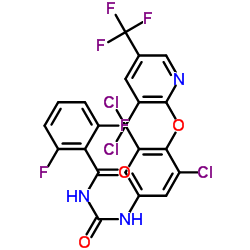AIM

AIM structure
|
Common Name | AIM | ||
|---|---|---|---|---|
| CAS Number | 71422-67-8 | Molecular Weight | 540.655 | |
| Density | 1.6±0.1 g/cm3 | Boiling Point | N/A | |
| Molecular Formula | C20H9Cl3F5N3O3 | Melting Point | 232-233.5ºC | |
| MSDS | Chinese USA | Flash Point | N/A | |
|
Bait matrix for delivery of chitin synthesis inhibitors to the formosan subterranean termite (Isoptera: Rhinotermitidae).
J. Econ. Entomol. 94(2) , 506-10, (2001) The efficacy of three chitin synthesis inhibitors, diflubenzuron, hexaflumuron, and chlorfluazuron, incorporated into a novel bait matrix to kill the Formosan subterranean termite, Coptotermes formosanus Shiraki, was evaluated in the laboratory. The bait matr... |
|
|
Areawide field study on effect of three chitin synthesis inhibitor baits on populations of Coptotermes formosanus and Reticulitermes flavipes (Isoptera: Rhinotermitidae).
J. Econ. Entomol. 104(3) , 1009-17, (2011) Periodic sampling of 43 independent monitors, initially active with Formosan subterranean termite, Coptotermes formosanus Shiraki, or the eastern subterranean termite, Reticulitermes flavipes (Kollar) (Isoptera: Rhinotermitidae), was conducted to evaluate the... |
|
|
Effects of various insecticides on the development of the egg parasitoid Trichogramma dendrolimi (Hymenoptera: Trichogrammatidae).
J. Econ. Entomol. 94(6) , 1340-3, (2001) The toxicity of six insecticides, acephate, methomyl, ethofenprox, cartap, chlorfluazuron, and Bacillus thuringiensis (Bt) was tested on different developmental stages of the egg parasitoid, Trichogramma dendrolimi (Matsumura). Each of the insecticides tested... |
|
|
Rapid report acetamiprid resistance and cross-resistance in the diamondback moth, Plutella xylostella.
Pest Manag. Sci. 60(9) , 839-41, (2004) A 110-fold acetamiprid-resistant Plutella xylostella (L) strain was established after four selection experiments (in five generations) on a 9.5-fold resistant colony in the laboratory. The resistant strain did not show cross-resistance to chlorfluazuron or Ba... |
|
|
Post-harvest HPLC determination of chlorfluazuron residues in pears treated with different programs.
Biomed. Chromatogr. 21(7) , 695-700, (2007) The present study was conducted to monitor the level of chlorfluazuron residues in pear samples in order to assess the risk posed by the presence of such residues to the consumer. Chlorfluazuron was sprayed onto pear trees at the recommended dose rate at two ... |
|
|
Laboratory evaluation of chlorfluazuron against larval phlebotomine sand flies (Diptera: Psychodidae).
J. Econ. Entomol. 87(5) , 1129-32, (1994) Laboratory experiments were conducted to evaluate the effectiveness of chlorfluazuron an insect growth-inhibitor against Lutzomyia longipalpis (Lutz & Neiva). Second- and third-instar L. longipalpis were exposed to four different doses (0.65, 0.75, 0.80, and ... |
|
|
Rate of decline of chlorfluazuron concentration in the fat of cattle.
Aust. Vet. J. 76(1) , 54-6, (1998) To determine the rate of decline of chlorfluazuron (CFZ) concentration in the fat of cattle.A field depletion study.Fifteen steers that had become contaminated with CFZ through eating cotton trash or cotton leaf pellets derived from CFZ-treated cotton crops.F... |
|
|
Hematological studies on white male rats exposed to some antimoulting compounds.
Bull. Environ. Contam. Toxicol. 43(1) , 60-5, (1989)
|
|
|
Determination of field-incurred chlorfluazuron residues in the peach.
Bull. Environ. Contam. Toxicol. 86(3) , 331-5, (2011) Chlorfluazuron residues were determined in the peaches that were sprayed at dosage (a.i. 0.0167 kg 10a(-1)), using an analytical method that was validated as follows; r (2) = 0.9999, 0.02 mg kg(-1) (LOQ) and 87.8-93.6% (recovery). The residues from all sample... |
|
|
Survival, developmental and morphogenic deficiencies of Parasarcophaga argyrostoma (Diptera: Sarcophagidae) induced by the biosynthesis inhibitor, chlorfluazuron (IKI-7899).
J. Egypt. Soc. Parasitol. 25(2) , 561-81, (1995) To evaluate the activity of benzoylphenyl urea chitin biosynthesis inhibitor chlorfluazuron (IKI-7899) against Parasarcophaga argyrostoma, seven doses were topically applied (once) onto early third (last) instar larvae, puparia, or newly formed pupa: 150, 100... |